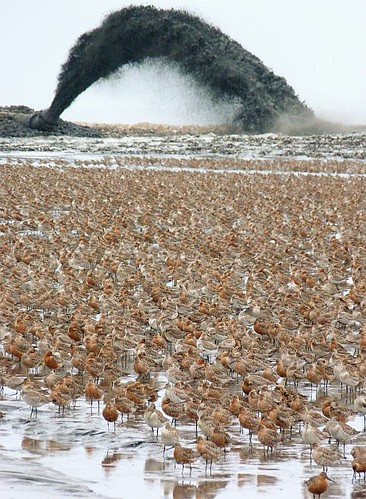黃海處在東亞-澳大利西亞候鳥遷徙路線的中段,屬於這條路線的“瓶頸”區域,相當於“咽喉”要道。黃海沿岸灘塗逐年萎縮,日益成為在澳洲和西伯利亞之間遷徙的候鳥所面臨的嚴重的問題。由荷蘭皇家海洋研究所資深科學家、荷蘭格羅寧根大學全球遷徙生態學教授托尼斯•皮爾斯馬(Theunis Piersma)牽頭,多名生態學家參與組成的國際科研團隊的最新研究成果發現,三種遷徙水鳥的種群數量由於一個共同的原因正在不斷下降,即:中國黃海沿岸大規模圍墾灘塗所造成的棲息地喪失及其直接或間接地導致食物供給量的減少。
該項研究成果將于近期發表於國際著名學術刊物《應用生態學雜誌》(Journal of Applied Ecology)。該研究涉及的三個候鳥物種是:在東西伯利亞北部島嶼繁殖的紅腹濱鷸(Calidris canutus piersmai),在西伯利亞東北部高山地區繁殖的大濱鷸(Calidris tenuirostris),以及在西伯利亞東北部低濕地地區繁殖的斑尾塍鷸(Limosa lapponica menzbieri)。三種候鳥都在澳大利亞西海岸的羅巴克灣(Roebuck Bay)越冬,並在遷徙過程中于黃海沿岸停歇、覓食,以補充能量。
造成下降的原因
根據上千隻的環志鳥類以及3萬多個環志目擊記錄,科研團隊的專家們可以估算2006年至2013年期間這三個物種每年以及每季度的存活率。在此期間它們在繁殖地產卵、孵化以及幼鳥出巢都沒有問題,同時在澳大利亞越冬地的存活狀態也屬正常。但是,自2010年起,這三種水鳥在春季和秋季的遷徙途中以及繁殖期間的存活率驟降。由於研究期間繁殖地的積雪融化相對較早,所以繁殖地的存活率沒有理由與其他年份該時期相比有任何的不同。因此,導致水鳥數量驟降的原因僅剩下一個,即沿黃海遷徙過程中的生存條件的變化——中國在這裡正開展著大規模灘塗圍墾,導致大量棲息地的喪失。
下降中的種群數量
皮爾斯馬教授科研團隊之前的研究也表明,濱鷸和塍鷸等鳥類的存活率在一年之中是均勻分佈的。2010年以前,在黃海沿岸棲息的濱鷸和塍鷸的存活率也一直如此,種群數量較為穩定。然而,在經歷了2011年和2012年的生存率驟降後,其種群數量也開始衰減。皮爾斯馬教授預測說:“如果生存率像這些年一樣持續下降,那麼在三到四年時間內其種群數量就會下降至一半。”
“各國政府通常不會因為生態和生物多樣性的因素而放棄經濟發展,除非有確鑿的證據證明這些發展對環境有負面影響,”皮爾斯馬教授接著說,“在國際鳥盟荷蘭分會和世界自然基金會荷蘭分會的資助下,我們完成的研究成果有力地證明了黃海沿岸的圍墾填海正在將候鳥推向危險的境地”

圖片說明:受圍墾影響的斑尾塍鷸。該圖攝於2012年4月20日,圖中在此地停歇補充能量的斑尾塍鷸只能棲息在一處正在疏浚作業的地方附近,清晰地反映出遷徙鴴鷸類在黃海沿岸棲息地快速喪失後所處的困境。疏浚物正通過一個碩大的管道排出,疏通進入遼寧東港漁港的通道。填實的區域計畫用作工業園區的一部分,該園區正是建立在2012年遼寧鴨綠江國家級自然保護區重新劃定功能區時所調整出的潮間帶灘塗上。
資料:
http://www.eaaflyway.net/the-yel ... migratory-birds-cn/
The shrinking of mudflats along the coasts of the Chinese Yellow Sea is an increasing problem for migratory birds that travel between Siberia and Australia. Research by an international team of ecologists, led by professor Theunis Piersma, a senior scientist at NIOZ Royal Netherlands Institute for Sea Research and professor in Global Flyway Ecology at the University of Groningen, shows that three different species are in decline because of one common factor: loss of food and habitat along the coasts of the Yellow Sea, because of the increasing claim of land by the Chinese government.
The research, to be published shortly in the Journal of Applied Ecology, involves three migratory bird species. The red knot (Calidris canutus piersmai) breeds on islands north of eastern Siberia. The great knot (Calidris tenuirostris) breeds in the alpine areas of north-eastern Siberia, and the bar-tailed godwit (Limosa lapponica menzbieri) breeds in the lower wetlands of north-eastern Siberia. All three of these species winter in Roebuck Bay, Western Australia. On their way between Asia and Australia they roost and refuel along the coasts of the Yellow Sea.
The cause
Thanks to thousands of color ringed birds, and more than thirty thousand resightings of these birds, the ecologists were able to calculate the annual, as well as the seasonal survival of the three species between 2006 and 2013. The production of eggs and fledglings was no issue in that period. Also, the survival in their Australian wintering grounds was normal. However, from 2010 onwards, the survival showed a sharp decline in a period that included the spring and fall migration, as well as the breeding period. Because the snow melted relatively early on the breeding grounds in those years, there was no reason to believe that the survival was any different during that period. That left only one culprit: the conditions during migration along the Yellow Sea, where significant loss of habitat was going on because of land claim by the Chinese government.
Populations in decline
Previous research by the group of Piersma has shown that the survival of birds like the knot and the godwit is normally evenly spread across the year. Until 2010 this was also true for the knots and the godwits that roost along the shores of the Yellow Sea. The populations were stable. With the decline in survival in 2011 and 2012, however, the populations began to shrink. ‘Should the survival continue to shrink like it did in these years, we’ll see a decline in these populations to half within three or four years’, Piersma predicts.
‘Governments are usually not that keen on putting a halt on economic development in favour of nature and biodiversity, unless there is solid proof for negative effects on the environment’, Piersma says. ‘With this research, that was mainly funded by Birdlife Netherlands and WWF Netherlands, we delivered the proof that land claim around the Yellow Sea puts many migratory birds at risk.’
https://www.nioz.nl/news-detail/ ... for-migratory-birds

